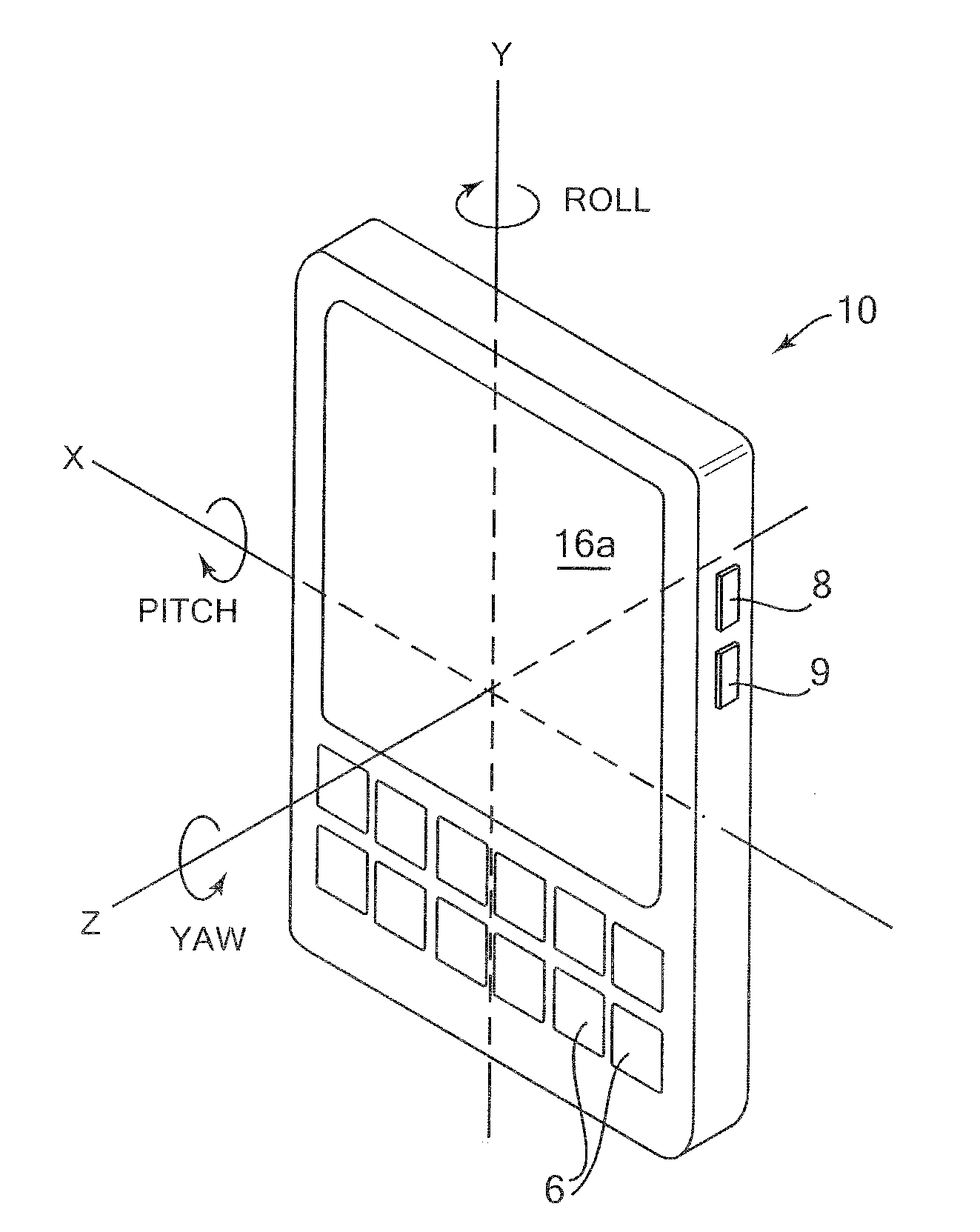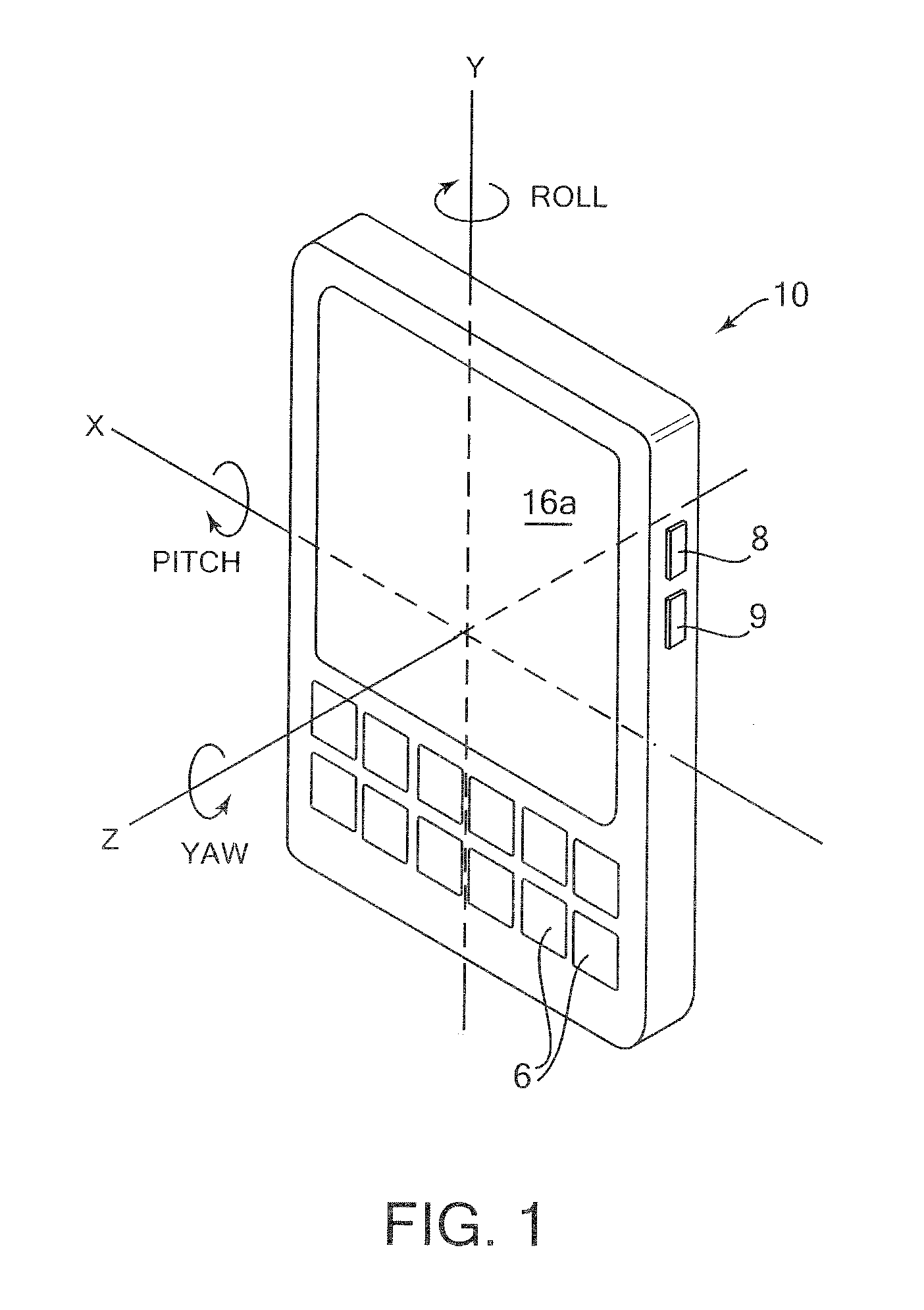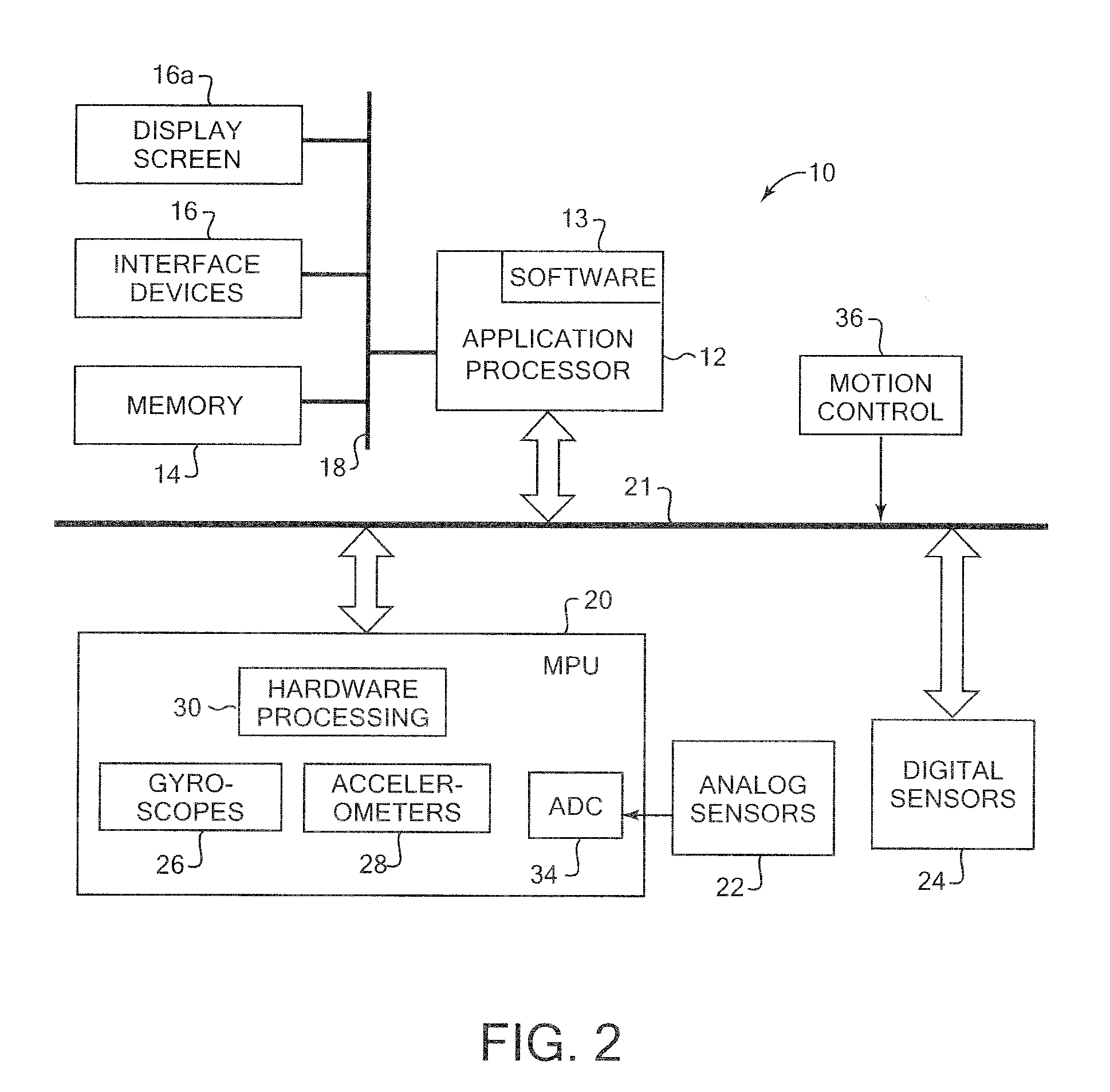However, controlling the multitude of functions of a handheld device can often be awkward or clumsy, due to the small size of the devices.
Such simple determination may not be acceptable for more sophisticated applications which would require gyroscopes or other applications having precise timing capabilities.
Also, motion of the device is not always linear or parallel to the ground, and many current devices will often not sense other types of motion accurately.
Therefore, existing devices are restricted in their
motion sensing ability, and limited in how they use
motion sensing to enable functions and control of the device.
The state of the current art, however, is still limited by the accuracy of
motion sensing that can be achieved via existing
motion sensors integrated in single devices and known implementations are not adequate to serve as a platform for development of a handheld device with integrated motion sensors, where the device facilitates personal communications and provides access to visual content made available by or through the device.
Generally, these devices have been relatively-large devices, not fit for handheld applications directed at end users, and instead deployed in industrial or military settings.
It is unlikely, however, that in such an application, if it existed, any significant integration of gyroscopes and accelerometers has been achieved.
Further, many interactions with applications on a hand-held device via motion of the device, such as icon selection, menu selection or
list scrolling, would be impractical or impossible via such a military head-worn visual display (e.g., shaking a phone to activate a feature is feasible, but shaking the head to achieve the same result on a head-worn visual display is not).
Consequently, such military devices do not serve as good platforms for developing a handheld device with integrated motion sensors that facilitates personal communications and provides access to visual content made available by or through the device.
No company has attempted to modify such
military systems into such a communication handheld device, and indeed such a modification would be inappropriate, counterintuitive and not economically feasible.
Additional devices and components have been introduced on the market providing various degrees of integration of accelerometers and sensors, but none of them provide 3-axis
gyroscope and 3-axis
accelerometer motion sensors for sufficient accuracy and serve as adequate building blocks for next generation handheld mobile devices.
The two sets of sensors may be disposed relatively far from each other, which introduces spatial separation between the two sets of sensors, making unified
motion detection more difficult and less accurate.
Furthermore, the two sets of sensors may rely on communication via the interface between the two distinct units, which can make synchronization of the data from the accelerometers and gyroscopes more difficult and inaccurate.
Some devices also do not integrate a display subsystem to permit direct interaction with games (whether an actual display or logic capable of substantially producing an image to be displayed on an external device).
Consequently, such devices do not serve as a good platform for developing a handheld device with integrated motion sensors that facilitates personal communications and provides visual access to
graphical data, such as a
mobile phone with an integrated or external display.
This navigation-
assistive device does not disclose any specific integration of accelerometers and gyroscopes or any specific personal communication functionality.
Further, the device of US20090066637A1 is not adapted or intended to facilitate user interaction with content beyond a map.
Consequently, US20090066637A1 does not disclose, and does not suggest any desirability or avenue for the development of, a handheld device that incorporates a set of closely-integrated
accelerometer and
gyroscope motion sensors, where the device facilitates personal communications and provides access to a broad range of visual content made available by or through the device.
US20080034321A1 does not disclose any architectural details of how a
gyroscope could be introduced into the handheld device disclosed in that application, and does not contemplate any close integration between one or more accelerometers and a gyroscope.
Consequently, US20080034321A1 does not disclose, and does not suggest any desirability or avenue for the development of, a handheld device that incorporates a set of closely-integrated
accelerometer and gyroscope motion sensors, where the device facilitates personal communications and provides access to a broad range of visual content made available by or through the device.
US20060279542A1 does not disclose any architectural details of how the gyroscopes and accelerometers could be incorporated into the handheld device, and does not contemplate any close integration between one or more accelerometers and one or more gyroscopes.
Consequently, US20060279542A1 does not disclose, and does not suggest any desirability or avenue for the development of, a handheld device that incorporates a set of closely-integrated accelerometer and gyroscope motion sensors, where the device facilitates personal communications and provides access to a broad range of visual content made available by or through the device.
WO03001340A2 does not disclose any architectural details of how the gyroscopes and accelerometers could be incorporated into the handheld device, and does not contemplate any close integration between one or more accelerometers and one or more gyroscopes.
Consequently, WO03001340A2 does not disclose, and does not suggest any desirability or avenue for the development of, a handheld device that incorporates a set of closely-integrated accelerometer and gyroscope motion sensors, where the device facilitates personal communications and provides access to a broad range of visual content made available by or through the device.
US20030231189A1 does not disclose any architectural details of how the gyroscopes and accelerometers could be incorporated into the handheld device, and does not contemplate any close integration between one or more accelerometers and one or more gyroscopes.
Consequently, US20030231189A1 does not disclose, and does not suggest any desirability or avenue for the development of, a handheld device that incorporates a set of closely-integrated accelerometer and gyroscope motion sensors, where the device facilitates personal communications and provides access to a broad range of visual content made available by or through the device.
Prior art systems and methods such as the one described in the US20090037848A1 do not provide good platforms for developing a handheld device with integrated motion sensors that facilitates personal communications and provides access to visual content made available by or through the device.
Further, it is clear that none of these devices or components have achieved any significant integration of accelerometers and gyroscopes in a single module, and such integration is not in any way obvious, suggested by, or otherwise directly facilitated by the existing art.
 Login to View More
Login to View More  Login to View More
Login to View More 


